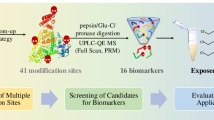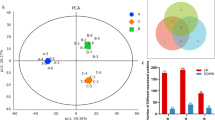Abstract
To explore the toxic effects of rare earth elements (REEs) accumulated in human body, adopting the inductively coupled plasma mass spectrometry (ICP-MS) method, the present study measured REEs and the contents of eight other elements (Ca, Fe, Cu, Na, K, Zn, Mg, and P) in the hair of eight persons exposed to soil containing REEs for a long time as well as in the control group. In addition, proteomic analysis of serum of the two groups was conducted by isobaric tags for relative and absolute quantitation (iTRAQ) technique. Experimental results show that in the hair of the two groups, 15 REEs and eight other elements were detected, in which the content of La, Ce, Pr, Nd, Tb, Ho, Tm, Yb, and Fe in the exposure group is significantly higher than that of the control group, but the content of Ca in the exposure group is significantly lower than that of the control group; analysis yields out 29 differentially expressed proteins, in which 16 proteins are upregulated and 13 proteins are downregulated. Bioinformatics analysis of differentially expressed proteins demonstrates that they participate in various biological processes and five Kyoto Encyclopedia of Genes and Genomes (KEGG) pathways, forming an interaction network. Besides, some differentially expressed proteins may be related to neurovirulence, hepatotoxicity, pathological fibrosis, osteoporosis, and anticoagulation caused by REEs. The present experiment investigated the toxic effects of REEs accumulated in human body at the molecular level, which may lay a foundation for the future research of biological effect, threshold limit values, protection from exposure, and reasonable application of REEs.


Similar content being viewed by others
References
Hirano S, Suzuki KT (1996) Exposure, metabolism, and toxicity of rare earths and related compounds. Environ Health Perspect 104(Suppl 1):85–95
Wason MS, Zhao J (2013) Cerium oxide nanoparticles: potential applications for cancer and other diseases. Am J Transl Res 5(2):126–131
Li R, Yang H, Wang K (2003) La accumulation and microstructure change of leg bones of rats fed with La(NO(3))(3) in low dosage for a long term. Beijing Da Xue Xue Bao 35(6):622–624
Wang Y, Nie L, Wang Q, Chen Q, Ge Y (2004) Effects of exposure to lathanum nitrate on micronucleus frequency of bone marrow cells among mice. J Environ Health 21(1):54–55
Zaichick S, Zaichick V, Karandashev V, Nosenko S (2011) Accumulation of rare earth elements in human bone within the lifespan. Metallomics 3(2):186–194
Chen Z (2005) Accumulation and toxicity of rare earth elements in brain and their potential effects on health. Rural Eco-Environment 21(4):72–73
Cheng J, Fei M, Sang X, Cheng Z, Gui S, Zhao X, Sheng L, Sun Q, Hu R, Wang L, Hong F (2014) Gene expression profile in chronic mouse liver injury caused by long-term exposure to CeCl3. Environ Toxicol 29(7):837–846
Zhao H, Hong J, Yu X, Zhao X, Sheng L, Ze Y, Sang X, Gui S, Sun Q, Wang L, Hong F (2013) Oxidative stress in the kidney injury of mice following exposure to lanthanides trichloride. Chemosphere 93(6):875–884
Samochocka K, Czauderna M, Konecki J, Wolna M (1984) The incorporation of Yb and Se into the brains of rats and their effect on the Zn level. Int J Appl Radiat Isot 35(12):1136–1137
Park KS, Cho SY, Kim H, Paik YK (2002) Proteomic alterations of the variants of human aldehyde dehydrogenase isozymes correlate with hepatocellular carcinoma. Int J Cancer 97(2):261–265
Ross PL, Huang YN, Marchese JN, Williamson B, Parker K, Hattan S, Khainovski N, Pillai S, Dey S, Daniels S, Purkayastha S, Juhasz P, Martin S, Bartlet-Jones M, He F, Jacobson A, Pappin DJ (2004) Multiplexed protein quantitation in Saccharomyces cerevisiae using amine-reactive isobaric tagging reagents. Mol Cell Proteomics 3(12):1154–1169
Wu WW, Wang G, Baek SJ, Shen RF (2006) Comparative study of three proteomic quantitative methods, DIGE, cICAT, and iTRAQ, using 2D gel- or LC-MALDI TOF/TOF. J Proteome Res 5(3):651–658
Parent N, Winstall E, Beauchemin M, Paquet C, Poirier GG, Bertrand R (2009) Proteomic analysis of enriched lysosomes at early phase of camptothecin-induced apoptosis in human U-937 cells. J Proteomics 72(6):960–973
Wang J, Tatsumoto M, Li X, Premo WR, Chao ECT (1994) A precise 232Th-208Pb chronology of fine-grained monazite: age of the Bayan Obo REE-Fe-Nb ore deposit, China. Geochim Cosmochim Acta 58(15):3155–3169
Yin M, Li B (1998) Determination of rare earth elements in human hair and wheat flour reference materials by inductively coupled plasma mass spectrometry with dry ashing and microwave digestion. Spectrochim Acta B At Spectrosc 53(10):1447–1454
Ye Y, Lee HW, Yang W, Shealy S, Yang JJ (2005) Probing site-specific calmodulin calcium and lanthanide affinity by grafting. J Am Chem Soc 127(11):3743–3750
Marsh M, McMahon HT (1999) The structural era of endocytosis. Science 285(5425):215–220
Rappoport JZ (2008) Focusing on clathrin-mediated endocytosis. Biochem J 412(3):415–423
Fischer P, Gotz ME, Danielczyk W, Gsell W, Riederer P (1997) Blood transferrin and ferritin in Alzheimer's disease. Life Sci 60(25):2273–2278
Kim BJ, Ahn SH, Bae SJ, Kim EH, Lee SH, Kim HK, Choe JW, Koh JM, Kim GS (2012) Iron overload accelerates bone loss in healthy postmenopausal women and middle-aged men: a 3-year retrospective longitudinal study. J Bone Miner Res 27(11):2279–2290
Vassar R, Coulombe PA, Degenstein L, Albers K, Fuchs E (1991) Mutant keratin expression in transgenic mice causes marked abnormalities resembling a human genetic skin disease. Cell 64(2):365–380
Blessing M, Schirmacher P, Kaiser S (1996) Overexpression of bone morphogenetic protein-6 (BMP-6) in the epidermis of transgenic mice: inhibition or stimulation of proliferation depending on the pattern of transgene expression and formation of psoriatic lesions. J Cell Biol 135(1):227–239
Carlsson L, Thornell LE (2001) Desmin-related myopathies in mice and man. Acta Physiol Scand 171(3):341–348
Ku NO, Darling JM, Krams SM, Esquivel CO, Keeffe EB, Sibley RK, Lee YM, Wright TL, Omary MB (2003) Keratin 8 and 18 mutations are risk factors for developing liver disease of multiple etiologies. Proc Natl Acad Sci U S A 100(10):6063–6068
Strnad P, Kucukoglu O, Lunova M, Guldiken N, Lienau TC, Stickel F, Omary MB (2012) Non-coding keratin variants associate with liver fibrosis progression in patients with hemochromatosis. PLoS One 7(3):e32669
Ze Y, Cheng J, Cai J, Cheng Z, Hu R, Hong F (2011) The impairment of liver DNA conformation and liver apoptosis of mice caused by CeCl3. Biol Trace Elem Res 143(1):437–445
Li N, Cheng J, Cheng Z, Hu R, Cai J, Gao G, Cui Y, Wang L, Hong F (2013) Molecular mechanism of inflammatory response in mouse liver caused by exposure to CeCl(3). Environ Toxicol 28(6):349–358
Petit V, Thiery JP (2000) Focal adhesions: structure and dynamics. Biol Cell 92(7):477–494
Schlaepfer DD, Mitra SK (2004) Multiple connections link FAK to cell motility and invasion. Curr Opin Genet Dev 14(1):92–101
Neuhaus G, Bowler C, Kern R, Chua NH (1993) Calcium/calmodulin-dependent and -independent phytochrome signal transduction pathways. Cell 73(5):937–952
Buccigross JM, Nelson DJ (1988) Interactions of spin-labeled calmodulin with trifluoperazine and phosphodiesterase in the presence of Ca(II), Cd(II), La(III), Tb(III), and Lu(III). J Inorg Biochem 33(2):139–147
Yang Q, Hu J, Yang X, Wang K (2008) Mastoparan/Mastoparan X altered binding behavior of La3+ to calmodulin in ternary complexes. J Inorg Biochem 102(2):278–284
Steinberg MS (1963) “ECM”: its nature, origin and function in cell aggregation. Exp Cell Res 30:257–279
Iozzo RV (1998) Matrix proteoglycans: from molecular design to cellular function. Annu Rev Biochem 67:609–652
Andy JJ (2001) Aetiology of endomyocardial fibrosis (EMF). West Afr J Med 20(3):199–207
Bukhman G, Ziegler J, Parry E (2008) Endomyocardial fibrosis: still a mystery after 60 years. PLoS Negl Trop Dis 2(2):e97
Nair RR, Preeta R, Smitha G, Adiga I (2003) Variation in mitogenic response of cardiac and pulmonary fibroblasts to cerium. Biol Trace Elem Res 94(3):237–246
Macfarlane RG (1964) An enzyme cascade in the blood clotting mechanism, and its function as a biochemical amplifier. Nature 202:498–499
Kostova I, Kostova R, Momekov G, Trendafilova N, Karaivanova M (2005) Antineoplastic activity of new lanthanide (cerium, lanthanum and neodymium) complex compounds. J Trace Elem Med Biol 18(3):219–226
Kramsch DM, Aspen AJ, Rozler LJ (1981) Atherosclerosis: prevention by agents not affecting abnormal levels of blood lipids. Science 213(4515):1511–1512
Block BM, Stacey WC, Jones SW (1998) Surface charge and lanthanum block of calcium current in bullfrog sympathetic neurons. Biophys J 74(5):2278–2284
Shorte SL, Schofield JG (1996) The effect of extracellular polyvalent cations on bovine anterior pituitary cells. Evidence for a Ca(2+)-sensing receptor coupled to release of intracellular calcium stores. Cell Calcium 19(1):43–57
Acknowledgments
This study was supported by the National Natural Science Foundation of China (no. 81160228).
Conflict of Interest
The material does not have a conflict of interest.
Ethical Approval
All procedures performed in studies involving human participants were in accordance with the ethical standards of the institutional and/or national research committee and with the 1964 Helsinki declaration and its later amendments or comparable ethical standards.
Informed Consent
Informed consent was obtained from all individual participants included in the study.
Author information
Authors and Affiliations
Corresponding author
Additional information
Heming Liu holds a Ph.D degree.
Jianzhong Wang holds a Ph.D degree.
Zenghua Yang holds a Ph.D degree.
Kunzheng Wang holds a Ph.D degree.
Rights and permissions
About this article
Cite this article
Liu, H., Wang, J., Yang, Z. et al. Serum Proteomic Analysis Based on iTRAQ in Miners Exposed to Soil Containing Rare Earth Elements. Biol Trace Elem Res 167, 200–208 (2015). https://doi.org/10.1007/s12011-015-0312-9
Received:
Accepted:
Published:
Issue Date:
DOI: https://doi.org/10.1007/s12011-015-0312-9




